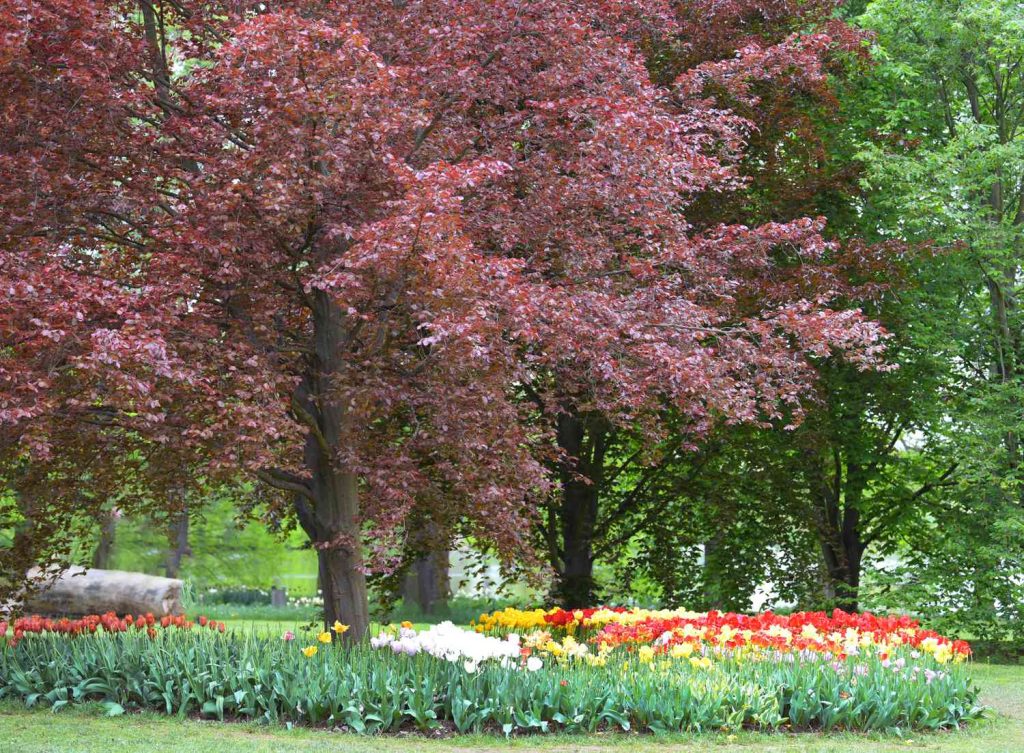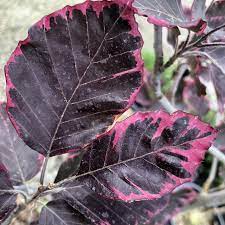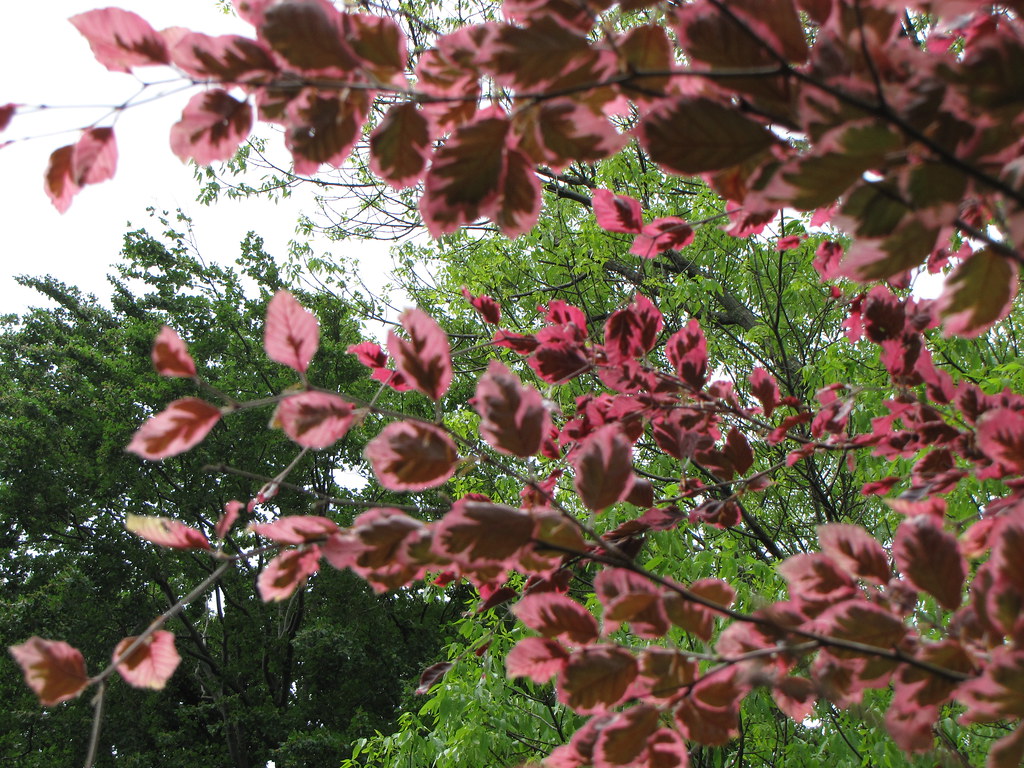The Tricolor Beech tree, known scientifically as the Fagus sylvatica Tricolor tree, is a wonderful ornamental tree that splashes color and elegance to any landscape. tricolor European Beech is renowned for its unique foliage, which combines shades of green, pink, and white. Here’s an in-depth look at the Tricolor Beech tree, covering its characteristics, planting, care, and common uses in landscaping.
Characteristics
- Appearance: The Tricolor Beech tree is notable for its leaves, which are a mix of dark green, white, and bright rosy pink color.
- Size: It typically grows to about 20-30 feet tall and 15-20 feet wide, making it a medium-sized tree.
- Tricolor Beech Tree Growth Rate: The tree has a slow to moderate growth rate and a rounded, spreading canopy that becomes quite dense.
- Bark and Branch Structure: The bark is smooth and gray, and provides a striking contrast to the colorful foliage. The branches tend to grow in a horizontal pattern, giving the tree a layered look.
- Seasonal Changes: In the fall, the leaves turn bronze, adding seasonal interest. During winter, the tree’s elegant branch structure becomes more prominent.
Tricolor Beech Tree Images


Planting and Site Selection
- Choosing the right location for planting a Tricolor Beech is essential. These trees thrive in well-drained, fertile soils that are rich in organic matter. A slightly acidic to neutral pH (between 5.5 and 7.0) is ideal, as this range supports optimal nutrient availability. Although the Tricolor Beech can tolerate a wide range of soil types, including sandy and clay soils, proper drainage is crucial because the roots are prone to rot in excessively wet conditions.
- Sunlight is another critical factor in site selection. The Tricolor Beech prefers full sun to partial shade; ideally, it should receive at least 4 to 6 hours of direct sunlight each day. Proper sunlight exposure enhances the foliage’s vibrant colors and overall vigor. In shadier conditions, the variegation may diminish, leading to less attractive foliage. However, it’s important to ensure that the site isn’t too windy, as young trees can be susceptible to
Planting Process:
- Timing: Plant the Tricolor Beech in early spring or fall when the weather is cool.
- Planting Depth and Spacing: planted same depth it grew in the nursery. Dig a hole twice as wide as the root ball and as deep.
- Watering After Planting: To retain moisture, water the tree generously after planting and mulch around the base.
Care and Maintenance:
- Watering: Regular watering is crucial, especially during dry spells. The tree’s shallow root system makes it sensitive to drought.
- Fertilizing: Use a balanced, slow-release fertilizer in the spring, but avoid over-fertilization, which can harm the tree.
- Pruning: Pruning should be minimal. Remove any dead or diseased branches to maintain the tree’s health and shape.
- Pest and beech leaf Disease Management: The Tricolor Beech is susceptible to pests like aphids and diseases like powdery mildew. Regular monitoring and appropriate treatments are necessary.
Common Uses in Landscaping:
- Specimen Tree: Its distinctive foliage makes it an excellent specimen tree for focal points in gardens.
- Mixed Borders: it can be used in mixed borders with other plants. The contrasting foliage creates a dramatic backdrop for perennials and shrubs.
- Shade Tree: In larger landscapes, it provides a lovely afternoon shade area with its broad canopy.
Challenges and Considerations:
- Sensitivity to Transplanting: Tricolor Beech trees can be sensitive to transplanting, requiring extra care during the process.
- Space Requirement: Due to its spreading habit, it needs ample space to grow, which might not be suitable for small gardens.
- Leaf Scorch: In hot climates or during periods of drought, leaf scorch can occur, so proper watering and site selection are vital.
Conclusion:
The Tricolor Beech is a magnificent tree that offers year-round visual interest. Its unique foliage, elegant structure, and versatility in landscaping make it a coveted choice for gardeners and landscape designers. While it requires some care and consideration, especially regarding planting location and maintenance, the beauty it adds to the landscape is well worth the effort. By following the guidelines for planting, care, and maintenance, you can ensure that your Tricolor Beech remains a vibrant and healthy addition to your garden for years to come.
Question and Answer:
Question 1: What are the Distinctive Features of the Tricolor Beech Tree?
Answer: The Tricolor Beech, known scientifically as beech Fagus sylvatica ‘Tricolor’, is celebrated for its unique, variegated foliage. The leaves are a beautiful combination of green, pink, and white, which changes to a coppery-bronze in the fall. This medium-sized tree typically reaches 20-30 feet in height and 15-20 feet in width, with a rounded and dense canopy. Its smooth, gray bark and horizontal branch pattern add to its ornamental appeal.
Question 2: What Are the Ideal Growing Conditions for a Tricolor Beech?
Answer: The Tricolor Beech thrives in USDA hardiness zones 4 through 7, preferring temperate climates. It does best in well-drained, moist, and slightly acidic to neutral soil. The tree requires a location with full sun to partial shade for optimal leaf color vibrancy. It’s important to plant it in a spacious area to accommodate its growth both vertically and horizontally.
Question 3: How Should I Care for My Tricolor Beech Tree?
Answer: To care Tricolor Beech tree, ensure it receives regular watering. it has a shallow root system. slow-release fertilizer can be applied in spring, but avoid over-fertilizing. Pruning should be minimal and focused on removing any dead or diseased branches. Keep an eye out for pests like aphids and diseases like powdery mildew, and treat them as necessary.
Question 4: Can Tricolor Beech Tree Used in Landscape Design?
Answer: Absolutely! The Tricolor Beech is an excellent choice for landscape design due to its striking foliage and elegant structure. It’s often used as a specimen tree for creating a focal point in gardens. It can also be incorporated into mixed borders, providing a dramatic backdrop for other plants. In larger landscapes, its broad canopy makes it a lovely shade tree.
Question 5: Are There Any Special Considerations When Planting a Tricolor Beech?
Answer: Yes, there are a few special considerations. The Tricolor Beech is known to be sensitive to transplanting, so extra care is needed during this process. Ensure it’s planted at the same depth it grew in the nursery and water it generously after planting. It requires ample space due to its spreading habit, so it might not be suitable for smaller gardens. Additionally, in hot climates or during droughts, the tree can suffer from leaf scorch, so proper watering and site selection are crucial.

